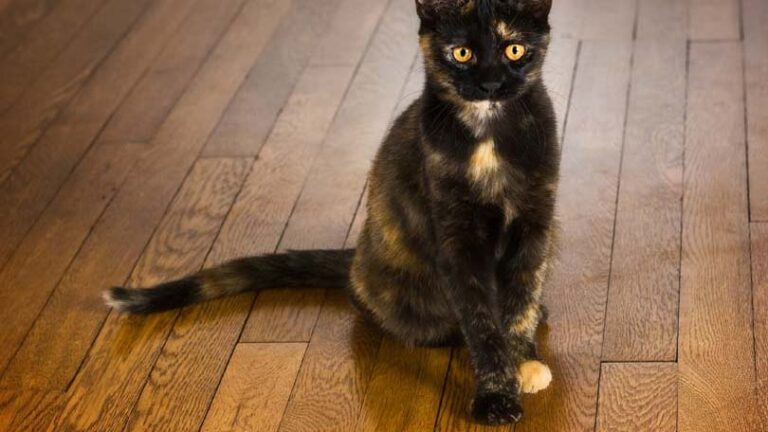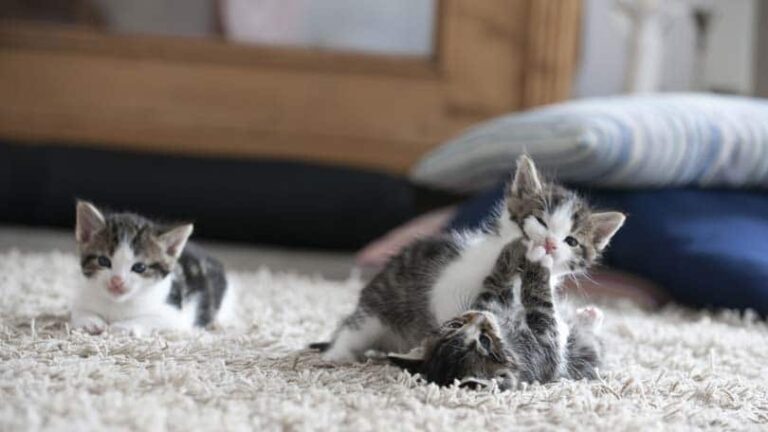How Big Do Cats Get? Unraveling the Complexities of Feline Anatomy
If you’re a pet parent, you must be wondering how big do cats get. If that’s the case, you should know that felines appear in an extensive range of dimensions, from the smallest infant cats weighing less than a kilogram to the biggest Maine Coon measuring 11 kg or more.
Although domestic cats rarely grow as huge as wild cats, certain ones can nevertheless reach fairly massive sizes. This complicated nature of the feline world is primarily determined by the immense variations in weight, height, and length.
So how do you know how big do cats get? While it’s hard to be completely certain, you can still come up with a decent approximation based on a wide range of variables, including genetics and habitat. Let’s discover more about feline development patterns and ways to assess how big do cats get!
5 Factors That Determine How Big Do Cats Get
1. Breed

One of the most significant factors in determining how big do cats get is their breed. Since they have an extended period for development before reaching maturity, bigger breeds require more time to accomplish growth.
For instance, the largest breed of cats, the Maine Coon, might take up to 4 years to reach maturity. Even though the typical domestic cat weighs between 3 and 6 kilograms, grows about 18 inches long, and is around 25 cm tall when fully grown, cats may be smaller or larger than average depending on their breed.
2. Gender

Male and female cats have different growth patterns, as males cease maturing later in life and evolve more slowly than female cats. Furthermore, adult male cats frequently surpass or achieve greater ranges of length, height, and weight for their breed, which contributes to the fact that male cats are typically bigger than female cats.
You may not have thought about it before, but now you know that how big do cats get is significantly affected by the cat’s gender.
3. Diet

Along with breed and gender, diet is another influential factor that impacts how big cats get. To grow to the right size, cats need to consume an excessive number of calories every day throughout their first few months of existence.
In light of this, improper feeding of cats may interfere with their physical development, which explains why some shelter cats are smaller when compared to their adopted peers.
4. Intact

How big cats get is additionally determined by the age at which they are spayed or sterilized. Recent research suggests that cats who are spayed or neutered at an early stage can become larger than cats who wait until they’re fully grown.
It’s essential to be aware that sterilizing a kitten too early could put them at risk for a bone injury known as a capital physeal fracture. This is frequently observed in bigger cat breeds or overweight male cats.
5. Genetics

While there is some natural variation in size among cats, feline dwarfism is frequently linked to a variety of health problems, including bone abnormalities brought on by nutritional imbalances and immune illnesses.
Dwarfism is a rare genetic abnormality that results in asymmetric and undersized development in cats and therefore affects how big do cats get. Pituitary dwarfism, osteochondrodysplasia, and selective dwarfism are the three primary manifestations of dwarfism in cats.
When Do Cats Reach Their Full Size?
At first glance, the answer to the commonly raised question “How big do cats get?” could seem straightforward. However, to comprehensively understand the deeper aspects of this issue, we need to learn more about the cat’s growth characteristics.
Cats attain adolescence at the age of 18 months, which is equivalent to 21 years in human years. Cats have the potential to increase in size between 12 and 18 months, both in terms of height and weight.
You may predict your cat’s size by measuring it when it’s 16 weeks old and doubling that number. It’s not an exact measurement, but you can anticipate that the number will be close to your cat’s adult size.
Although cats have the opportunity to grow after their initial year, the pace of their development will dramatically slow down thereafter. If you measure your cat on an ongoing basis, you’ll be able to identify when the measurements start to stabilize since cats continue to grow taller and bigger every month.
The 5 Largest Cats: Marvels of Feline World
1. Maine Coon

If you are wondering how big do cats get, you will definitely be fascinated to know that the Maine Coon is an immense cat that has a strong, athletic body in proportion to its incredible size. Due to their long bodies and relatively high weight, many people believe Maine Coons to be the biggest domestic breed. Maine Coons can weigh more than 11 kg and can effortlessly grow to reach over a meter long from the nose to the end of the tail.
The ordinary Maine coon stands 25 to 41 cm tall, however, Mymains Stewart Gilligan holds the record for being the world’s biggest Maine Coon measuring 123 cm in length, according to the Guinness World Records.
2. Savannah

The Savannah cat is known for its distinctive and wild appearance. This rare species, which might resemble a small cheetah, is a hybrid of domestic cats and the African serval, an average-sized wild cat with huge, pointed ears and a stunning spotted coat. Savannah cats tend to be larger than the majority of other domestic breeds as a result.
We are happy to satisfy your curiosity about how big do cats get, and more specifically, Savannahs. The biggest savannah cat measured about 43 cm from shoulder to toe, and some of them have been known to gain a healthy weight of more than 13 kg. Their height and weight measurements vary depending on how closely Savannahs are related to their wild Serval ancestors.
Savannah cats are wonderful companions as long as they are socialized from an early age. However, due to their inquisitive and needy personalities, they would do best with more seasoned owners.
3. Norwegian Forest Cat

It’s not surprising that Norwegian Forest cats, who are thought to have a similar ancestor to Maine coons, are also among the largest cats. When fully grown, this enormous cat often stands between 22 and 30 cm tall. They can appear considerably bigger due to their appearance being extremely fluffy, yet they typically weigh up to 10kg.
The Norwegian Forest cat, which is bigger than the ordinary cat and has a gorgeous semi-long coat to match, is both graceful and athletic. They are strong and sturdy, with a tall, triangular head, curled ears, long legs, and a magnificent bushy tail.
4. Ragdoll

When we are discussing how big cats get, we definitely have to mention the Ragdoll. The average grown-up ragdoll stands between 23 and 28 cm tall and has a solid, robust appearance. These huge, muscular, fluffy cats can weigh up to 9 kg. The nicest thing about ragdolls, in addition to their enormous size and fluffy coats, is that they are recognized for being gentle and friendly, making them the ideal companions.
A ragdoll cat is distinguished by its long, bushy tail, and as it ages, its coat develops into fluffy tights on the back legs and a graceful ruffle around the neck and throat.
Given their amiable demeanor and laid-back character, Ragdoll cats are beloved by both families and individuals. They would gladly portray an excellent companion to anyone they encounter and adore spending the day interacting with their owners.
5. Chausie

The Chausie is a domestic cat with wild origins that has an imposing frame and equally long legs. The Chausie, which was not officially recognized as a domestic breed until 1995, is thought to be a cross between domestic cats from Ancient Egypt and a particular species of wild jungle cat.
Chausie commonly measures between 35.56 and 45.72 cm in height and features broad, rounded ears, short fur, and a deep chest. Even though Chausies can weigh more than 11 kg, they are renowned for being lively and energetic cats that form deep bonds with their loved ones.
We have recently covered the most fascinating cat species, a thorough comprehension of which will convince everyone of how immense and amazing the feline world is. Therefore, the response to your question, “how big do cats get?” now becomes apparent.
How Are Physical Size & Intelligence Connected in Cats?
Cat intelligence is described as the capacity to store knowledge gained from experiences and apply it to difficulties in novel environments. The brain of a cat weighs between 25 and 31 grams and makes up roughly 0.9 percent of its body mass. Surface folds and brain structure, rather than a cat’s overall size, are what matter most when determining how intelligent they are.
Even under experimental circumstances, it was shown that cats of all sizes had memories that could retain or recover knowledge for up to 10 years on average. The fact that cats have fully formed conceptions of object permanence indicates that their perceptual intelligence is thoroughly developed, and even in-depth research demonstrates that there is no direct relationship between cats’ intellect and their physical size.
Final Thoughts
Are you still curious about how big do cats get? We hope to succeed in trying to provide you with comprehensive information!
Now you are aware that, in addition to environmental influences, cats’ sizes are influenced by a combination of genetic characteristics, gender variations, and environmental factors. The feline population features many amazing characteristics, and while size and appearance variation aren’t nearly as significant as personality, they are nonetheless phenomenal!

Nato is a content writer and researcher with a background in psychology who’s eager to explore the wonders of nature. As a travel enthusiast and animal lover, she hopes to inspire others to discover and cherish the beauty and importance of the natural world.







